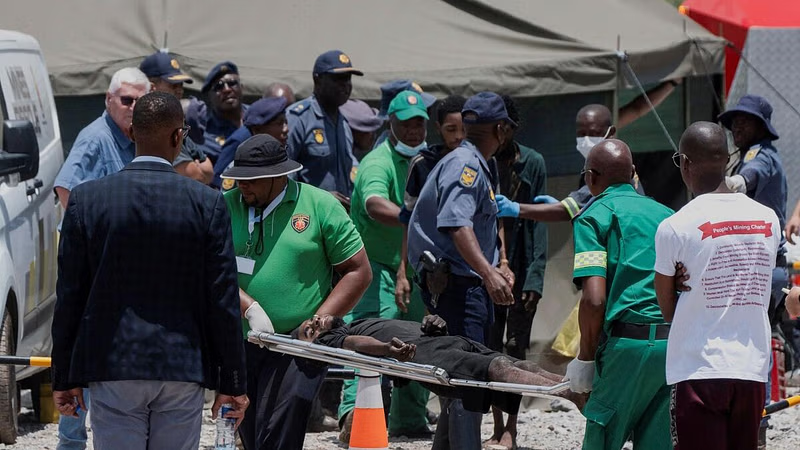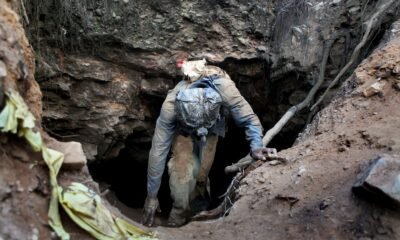Trends
Did The South African Govt ‘Starve’ The Holed Up Miners To Death? What Stopped The Miners From Coming Out?
Published
6 months agoon

In a haunting tragedy that unfolded beneath the dusty plains of Stilfontein, South Africa, a months-long standoff between authorities and illegal miners or Zama Zama as they are called, trapped in an abandoned mine culminated in an unimaginable loss of life.
At least 78 miners, hidden in the labyrinthine depths of the mine, have perished—likely from starvation—while 246 survivors emerged gaunt, broken, and traumatized. This was no natural disaster but a crisis marked by allegations of neglect, cruelty, and a failure to act.
The Making of a Tragedy
It began in September when hundreds, possibly thousands, of miners found themselves ensnared in the dark confines of the Stilfontein mine. The mine, a relic of South Africa’s gold rush, became a death trap when police sealed its exits and blocked the delivery of essential supplies, citing the need to “smoke them out.” What followed was a horrendous tale of human suffering, compounded by a delayed rescue effort and mounting accusations of governmental apathy.
The mine, with its vast, interconnected shafts, spans kilometers underground. While the police claimed the miners could escape through alternate exits, activists countered that these entryways were inaccessible, effectively trapping the miners in a living grave. Families of the trapped miners begged for a rescue mission, but their cries were met with silence and bureaucratic indifference.
Starvation, Desperation, and Death
For weeks, the miners endured unspeakable conditions. Survivors recounted harrowing tales of eating cockroaches and, in moments of absolute despair, resorting to cannibalism to stay alive. Videos that surfaced in January, showing piles of decomposing bodies, sent shockwaves across the nation and the world. Some miners attempting to escape fell to their deaths in the treacherous tunnels.
It was not until October—weeks after the standoff began—that a court order forced the police to allow limited food supplies to be sent down the shafts. Even then, the rescue efforts were sporadic and painstakingly slow, with community members risking their lives to lower ropes and pull up survivors.
By November, authorities reluctantly considered using cages for evacuation after a body was retrieved using rudimentary methods. However, the delay in taking decisive action meant that for many, help came too late.

The Fallout. A “Massacre” of Neglect
Rights groups have condemned the South African government for what they are calling a “massacre.” Cutting off food and water to the miners for weeks was a decision they argue amounted to a death sentence. Minister in the Presidency Khumbudzo Ntshavheni’s statement that the miners would be “smoked out” has drawn fierce criticism, symbolizing the state’s callous approach to the crisis.
The rescue operation, finally launched in January, was driven more by public outcry and legal pressure than by any sense of urgency. When it ended on Thursday, the authorities declared that no more survivors or bodies remained underground, basing their conclusion on footage from cameras sent into the mine. But for many, this resolution comes far too late.
What Stopped the Miners from Coming Out?
The Stilfontein mine, a sprawling network of tunnels and shafts, was as much a psychological prison as it was a physical one. Fear of arrest, coupled with the logistical impossibility of accessing the vast underground network to find alternative exits, kept the miners holed up. The police’s blockade ensured that even those who dared to emerge faced starvation, dehydration, or worse.
Last week, under judicial pressure, the South African police initiated a rescue operation after months of inaction. A specialist mining rescue company was brought in, deploying a small cage down the treacherous shaft. In a display of courage, two community members volunteered to descend into the darkness after police deemed it unsafe.
In total, 324 people were retrieved from the mine, some barely clinging to life, others tragically lifeless. Families are still waiting for closure, haunted by the uncertainty of whether their loved ones will ever return.
The Curse of Illegal Mining
South Africa’s illegal mining industry is a sprawling and dangerous enterprise, with informal miners—zama zamas or “hustlers”—scouring the remnants of over 6,000 abandoned gold mines. These miners, often undocumented migrants from neighboring countries like Mozambique, Zimbabwe, and Lesotho, risk life and limb in search of gold deposits. Armed with little more than picks and buckets, they burrow into unstable shafts, living underground for months, dependent on external contractors for supplies.
But the industry’s shadow extends beyond the miners themselves. Criminal syndicates dominate the trade, exploiting miners and engaging in gang wars that spill into the streets. Officials estimate that illegal mining costs South Africa over $1 billion annually in lost revenue. For the zama zamas, this is a grim lottery where the price of survival often exceeds the gains of their labor.
Why Did the Government Delay?
The question that needs asking is why the South African government waited so long to intervene. From the outset, officials deflected blame. Police spokesperson Athlende Mathe insisted the fault lay with criminal syndicates controlling the illegal trade. Others pointed fingers at Buffelsfontein Gold Mine (BGM), the entity responsible for securing the Stilfontein mine, accusing it of negligence in failing to prevent trespassers.
In December 2023, the government launched “Close the Hole” (Vala Umgodi in Zulu), a joint police and military operation aimed at cracking down on illegal mining. The strategy involved sealing mine entrances, cutting off provisions, and forcing miners to surface. By the time of the Stilfontein tragedy, officials claimed the operation had driven over 1,000 miners out of other mines, seized explosives and firearms, and confiscated over $2 million in cash.
But in Stilfontein, this strategy proved fatal. The decision to block supplies and delay rescue efforts condemned many miners to slow, agonizing deaths.
Escaping Death, But Not Justice
In November, a group of 14 miners, including a teenager, managed to escape the unsealed Stilfontein shaft after hours of grueling effort. Their testimonies painted a harrowing picture of life underground: deaths, starvation, and even threats of violence from armed bosses who sought to keep them captive.
Despite these warnings, police officials refused to initiate a rescue, arguing that the escape proved miners could leave on their own. Activists, however, countered that such escapes were rare, dangerous, and beyond the capacity of most miners weakened by days without food or water.
Rights groups and community members have been unequivocal in their criticism of the government. Activists like Mzukusi Jam believe the authorities acted only under pressure, while the Mining Affected Communities United in Action (MACUA) labeled the crisis a “massacre, if not a genocide.”
MACUA spokesperson Magnificent Mndebele accused the government of weaponizing starvation, calling it a “calculated” response to force miners out of the shafts. He also spoke about the disregard for human rights during the months-long standoff, citing reports of miners resorting to eating toothpaste and fighting over scarce food supplies.
Jessica Lawrence, from Lawyers for Human Rights, condemned the police for facilitating conditions that led to mass deaths. “We cannot become a society where we allow police officers to facilitate the death or starvation and dehydration of people, regardless of their activities underground,” she said.
Xenophobia and Racism in Focus
MACUA’s Mndebele also accused government officials of exploiting anti-migrant sentiments. The majority of the miners were undocumented migrants from neighboring countries, and Mndebele argued that the state’s response reflected a xenophobic and racist bias.
“Because they are illegal miners and are foreigners, they are not worthy of any human rights – that was the approach of the state,” he said bluntly.
As survivors receive medical care and await trial, political and public pressure mounts for accountability. The Democratic Alliance (DA), South Africa’s second-largest political party, has demanded a full and transparent investigation into the crisis.
In a letter to President Cyril Ramaphosa, DA spokesperson James Lorimer called for a probe into the roles of government agencies, mine owners, and operators. Lorimer emphasized the need for swift action, saying, “A transparent investigation will help uncover the full scope of the crisis and prevent future tragedies of this nature.”
The Stilfontein mine disaster has laid bare the intersecting issues of poverty, exploitation, xenophobia, and systemic neglect that plague South Africa’s illegal mining industry. While the court-mandated rescue operation brought some relief, it also exposed the harrowing cost of inaction.
As investigations loom and public outcry grows, the tragedy at Stilfontein is not just a story of illegal mining but an indictment of how far a society can fall when human lives are measured by their legal status or economic utility.
Likewise, they are victims of systemic inequality, exploited by syndicates and overlooked by a government more focused on punitive measures than on addressing the root causes of the crisis.
The Last Bit
The Stilfontein tragedy lays bare the grim realities of South Africa’s illegal mining industry and the state’s failure to address it humanely. While the miners’ actions may have been unlawful, their humanity was undeniable. Yet, the government’s approach—marked by indifference, delay, and a chilling lack of compassion—turned a preventable crisis into a full-blown catastrophe.
Could more lives have been saved if the government had acted sooner, or was this massacre of neglect inevitable in a system that too often devalues the lives of the vulnerable? For the miners who perished in Stilfontein, justice will come not through blame but through meaningful change in how the nation confronts its darkest depths.





